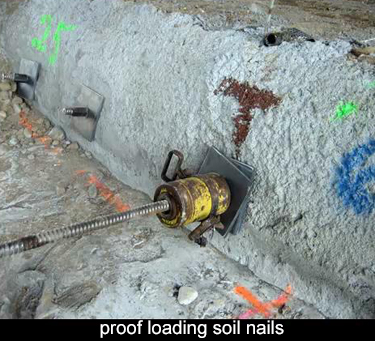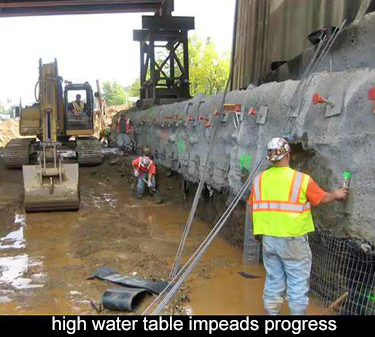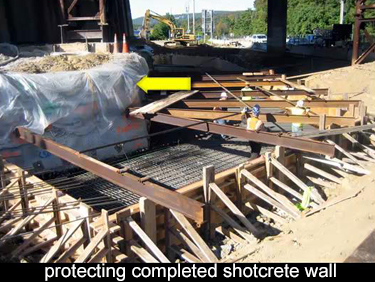Here's a detailed view of the soil nail. A high-strength steel rod is being installed and you can see that the drill bit has been attached to the end of the rod. That's an efficient way of doing this, but the drill bit is actually lost in the hole.
These are shallow rods and called soil nails. A similar arrangement is used to install earth anchors. They are much deeper and much higher capacity, and they would be attached to a whaler and would carry a much higher load. This is kind of a light version of a soil anchor. When it's used this way, it's called a soil nail.
 Each of the soil nails is preloaded with a hydraulic jack. That way you are certain that it has reached the capacity that you're looking for. Then that load is transmitted into the shotcrete wall by means of these flat steel plate washers.
Each of the soil nails is preloaded with a hydraulic jack. That way you are certain that it has reached the capacity that you're looking for. Then that load is transmitted into the shotcrete wall by means of these flat steel plate washers.
This is a good view of the general excavation. They've pretty much gone down to the bottom of the footing, and they've run into groundwater. The groundwater on the contract drawings was shown to be below the bottom of the footing, but, unfortunately, they are running into it in the course of the excavation.
 I want to point out the temporary tower in the background. You can see how precariously it is poised at the side of the excavation. Of course, the loads have been transmitted by means of drilled in piles to a point below the excavation, so that it is resting on those six drilled in piles. You can begin to understand how installing soldier piles and lagging, or any other method, would have been inadequate in terms of trying to support that concentrated load.
I want to point out the temporary tower in the background. You can see how precariously it is poised at the side of the excavation. Of course, the loads have been transmitted by means of drilled in piles to a point below the excavation, so that it is resting on those six drilled in piles. You can begin to understand how installing soldier piles and lagging, or any other method, would have been inadequate in terms of trying to support that concentrated load.
To overcome that unexpected high water table, they put in several local wells. They are drilled in and filled with crushed stone. Then, a submersible pump is installed in each one. They proved to be very effective and were able to manage that high water table.
 Here, you can see the abutment, which is under construction. Take note of how carefully they have protected the shotcrete. Both the face of the shotcrete and the area behind the shotcrete has been covered with plastic. Obviously, this requires some care and some attention. This is not Soldier piles and lagging, which is extremely robust. You can install it and forget about it. Here, they are taking very good care of it. I don't know if it would be fair to describe this as being rather fragile, but it certainly requires some careful attention.
Here, you can see the abutment, which is under construction. Take note of how carefully they have protected the shotcrete. Both the face of the shotcrete and the area behind the shotcrete has been covered with plastic. Obviously, this requires some care and some attention. This is not Soldier piles and lagging, which is extremely robust. You can install it and forget about it. Here, they are taking very good care of it. I don't know if it would be fair to describe this as being rather fragile, but it certainly requires some careful attention.
They also made a judgment now that the footing is underway. They decided to proceed with shifting the traffic up above and removing one half of the bridge. The original plan was to wait until this abutment was constructed as far as possible, but I think they see their very limited gains in using that original concept, and now want to carry out the abutment construction and the removal of one half of the bridge simultaneously. That will certainly shorten the overall duration. I have some video showing that traffic shift.
After the morning peak, traffic can be contained into a single lane and that's what's being done here. That frees up the adjoining lane. At this point, they are delivering a impact attenuator. That's going to be used the temporarily, as the traffic is shifted. With one lane closed, you can now extend the concrete barriers into that closed lane and go as far as you can with them. You attach this impact attenuator to the end of the barriers, and then you can redirect the traffic into the new configuration.
 Now, to deliver this item, they've closed the parkway entirely, but just for a few minutes. Once they have this more or less in place, they can restore the flow of traffic. Here, the concrete barriers will be extended to occupy the space of that closed lane. When that is done, the impact attenuator will be attached to the last barrier. At that point, that single lane of traffic can be shifted onto the new alignment that frees up the old roadway. There's now no traffic on the old roadway and the concrete barriers can be installed to form the new traffic pattern.
Now, to deliver this item, they've closed the parkway entirely, but just for a few minutes. Once they have this more or less in place, they can restore the flow of traffic. Here, the concrete barriers will be extended to occupy the space of that closed lane. When that is done, the impact attenuator will be attached to the last barrier. At that point, that single lane of traffic can be shifted onto the new alignment that frees up the old roadway. There's now no traffic on the old roadway and the concrete barriers can be installed to form the new traffic pattern.
These trucks will do the striping on the day of the traffic shift. You have to be able to put down the permanent striping pattern. This is very critical, because the traffic will be in a new configuration, and they will be very much guided by the new painted lines. If the new lines are in conflict with some existing line, those existing lines need to be removed.
The impact attenuator is now going to be installed to protect the end of that concrete barrier. Obviously, you need to protect the traffic against that exposed end. At that point, traffic can be shifted onto the new alignment and there will be no traffic on the old roadway, so that the barriers can be reconfigured to accommodate the new traffic alignment.